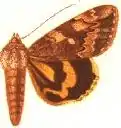| Little nymph underwing | |
|---|---|
 | |
_(14447136875).jpg.webp) | |
| Scientific classification | |
| Domain: | Eukaryota |
| Kingdom: | Animalia |
| Phylum: | Arthropoda |
| Class: | Insecta |
| Order: | Lepidoptera |
| Superfamily: | Noctuoidea |
| Family: | Erebidae |
| Genus: | Catocala |
| Species: | C. micronympha |
| Binomial name | |
| Catocala micronympha | |
| Synonyms | |
| |
Catocala micronympha, the little nymph underwing or little bride underwing, is a moth of the family Erebidae. The species was first described by Achille Guenée in 1852. It is found in North America from southern Ontario, Quebec, and Manitoba through New Hampshire, Connecticut, and New Jersey to Florida, west to Texas and then north through Oklahoma, Kansas, Iowa, to Wisconsin and Minnesota and then east to Michigan.

Lectotype of Catocala gisela, now considered to be a synonym of Catocala micronympha

The wingspan is 35–50 mm. Adults are on wing from April to September depending on the location. There is probably one generation per year.
The larvae feed on Quercus macrocarpa, Quercus stellata, and Quercus virginiana
References
Wikimedia Commons has media related to Catocala micronympha.
Wikispecies has information related to Catocala micronympha.
- ↑ Yu, Dicky Sick Ki. "Catocala micronympha Guenee". Home of Ichneumonoidea. Taxapad. Archived from the original on March 15, 2016.
External links
This article is issued from Wikipedia. The text is licensed under Creative Commons - Attribution - Sharealike. Additional terms may apply for the media files.